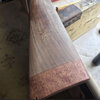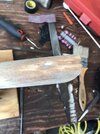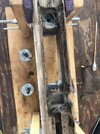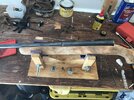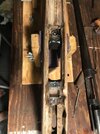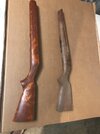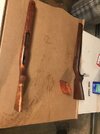I’ve decided to start a journey into learning how to clean, repair, and refinish old stocks. I am starting with a low-stakes stock from a Ranger bolt action 20 gauge. It’s not much to look at and has no collectors value. Its sentimental value is that it was the first gun my grandfather bought with his own money. Since then he took the poly choke off with a hacksaw and shortened the stock significantly. I figure it’s a good candidate for learning.
I cleaned off what little finish was there and the wood isn’t too bad. Denatured alcohols made quick work of it. It was finished like you would expect for a shotgun that retailed at $20. Really rough on the inside but mostly solid. I’ll get around to finishing later, that shouldn’t be too hard though.
I found two problems to consider. The first is the intersection of a sling swivel and recoil pad screw hole. That just needs filler but I’m open to suggestions on the best filler.
significantly.

The other is more complicated since it looks like where the front action screw meets the stock. The main recoil lug contact is fine though. I’m sure there’s an ingenious way to patch it, but not sure how.



I’ve been looking back at some of the stock repair threads by @GunnyUSMC but couldn’t see these exact issues, so I figured it’s a good time to toss it out there.
I cleaned off what little finish was there and the wood isn’t too bad. Denatured alcohols made quick work of it. It was finished like you would expect for a shotgun that retailed at $20. Really rough on the inside but mostly solid. I’ll get around to finishing later, that shouldn’t be too hard though.
I found two problems to consider. The first is the intersection of a sling swivel and recoil pad screw hole. That just needs filler but I’m open to suggestions on the best filler.
significantly.

The other is more complicated since it looks like where the front action screw meets the stock. The main recoil lug contact is fine though. I’m sure there’s an ingenious way to patch it, but not sure how.



I’ve been looking back at some of the stock repair threads by @GunnyUSMC but couldn’t see these exact issues, so I figured it’s a good time to toss it out there.





